Financial Management: Importance, Analysis, and Improvement
VerifiedAdded on 2022/12/01
|15
|2873
|68
Report
AI Summary
This report provides a comprehensive overview of financial management, emphasizing its critical role in business operations. It begins with an introduction to financial management, followed by an examination of main financial statements including income statements, balance sheets, cash flow statements, and statements of retained earnings. The report then delves into the application of financial ratios, such as profitability, liquidity, and efficiency ratios, to assess an organization's financial health and performance. Comparisons using applied research and pattern lines are also discussed. The report further explores how to improve financial performance through effective working capital management and goal setting. The report also includes analysis of financial ratios for 2015 and 2016, highlighting trends in profitability and liquidity. The report concludes with a discussion on improving financial performance through various strategies.

Importance of Financial Management
Paraphrase This Document
Need a fresh take? Get an instant paraphrase of this document with our AI Paraphraser
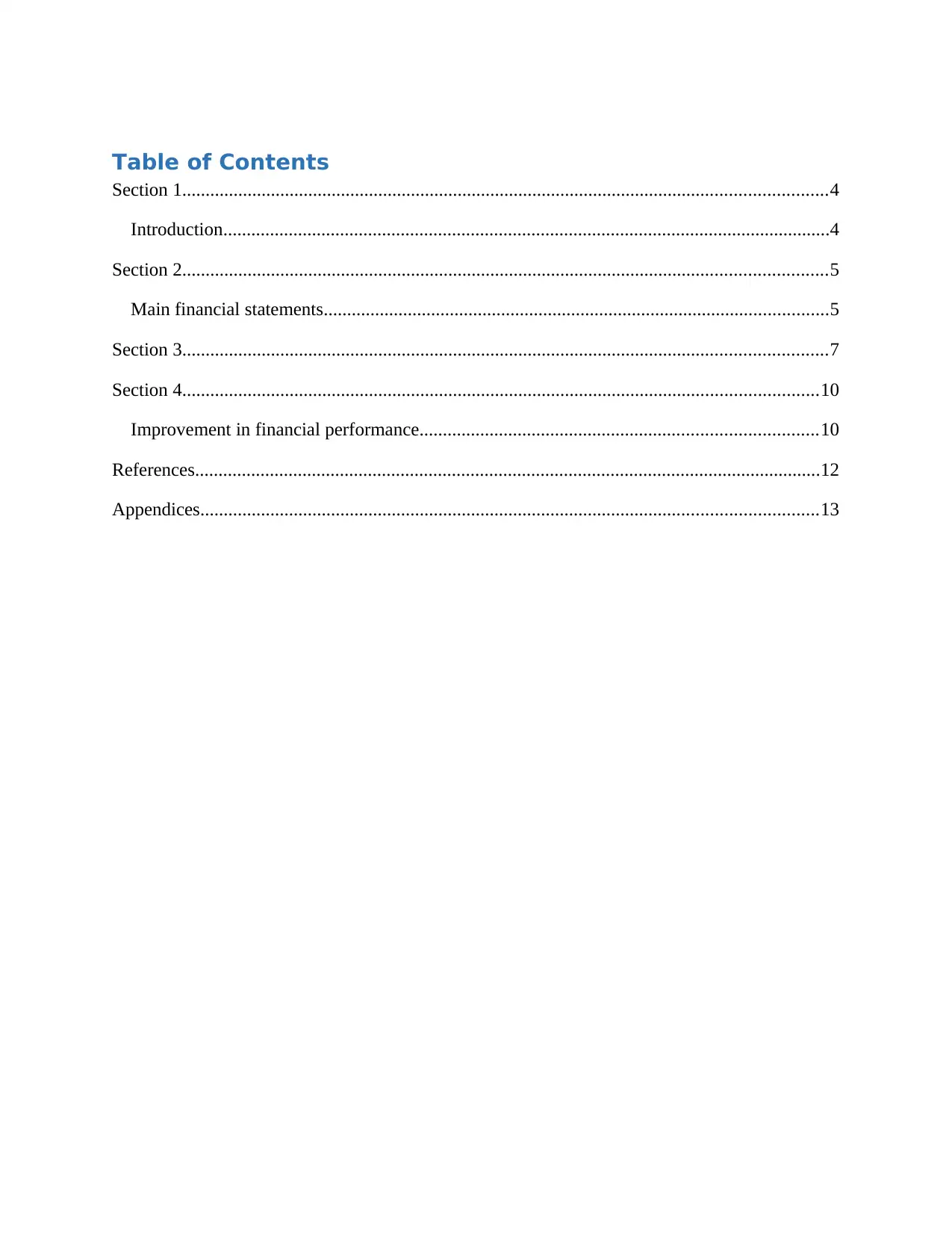
Table of Contents
Section 1..........................................................................................................................................4
Introduction..................................................................................................................................4
Section 2..........................................................................................................................................5
Main financial statements............................................................................................................5
Section 3..........................................................................................................................................7
Section 4........................................................................................................................................10
Improvement in financial performance.....................................................................................10
References......................................................................................................................................12
Appendices....................................................................................................................................13
Section 1..........................................................................................................................................4
Introduction..................................................................................................................................4
Section 2..........................................................................................................................................5
Main financial statements............................................................................................................5
Section 3..........................................................................................................................................7
Section 4........................................................................................................................................10
Improvement in financial performance.....................................................................................10
References......................................................................................................................................12
Appendices....................................................................................................................................13

⊘ This is a preview!⊘
Do you want full access?
Subscribe today to unlock all pages.

Trusted by 1+ million students worldwide
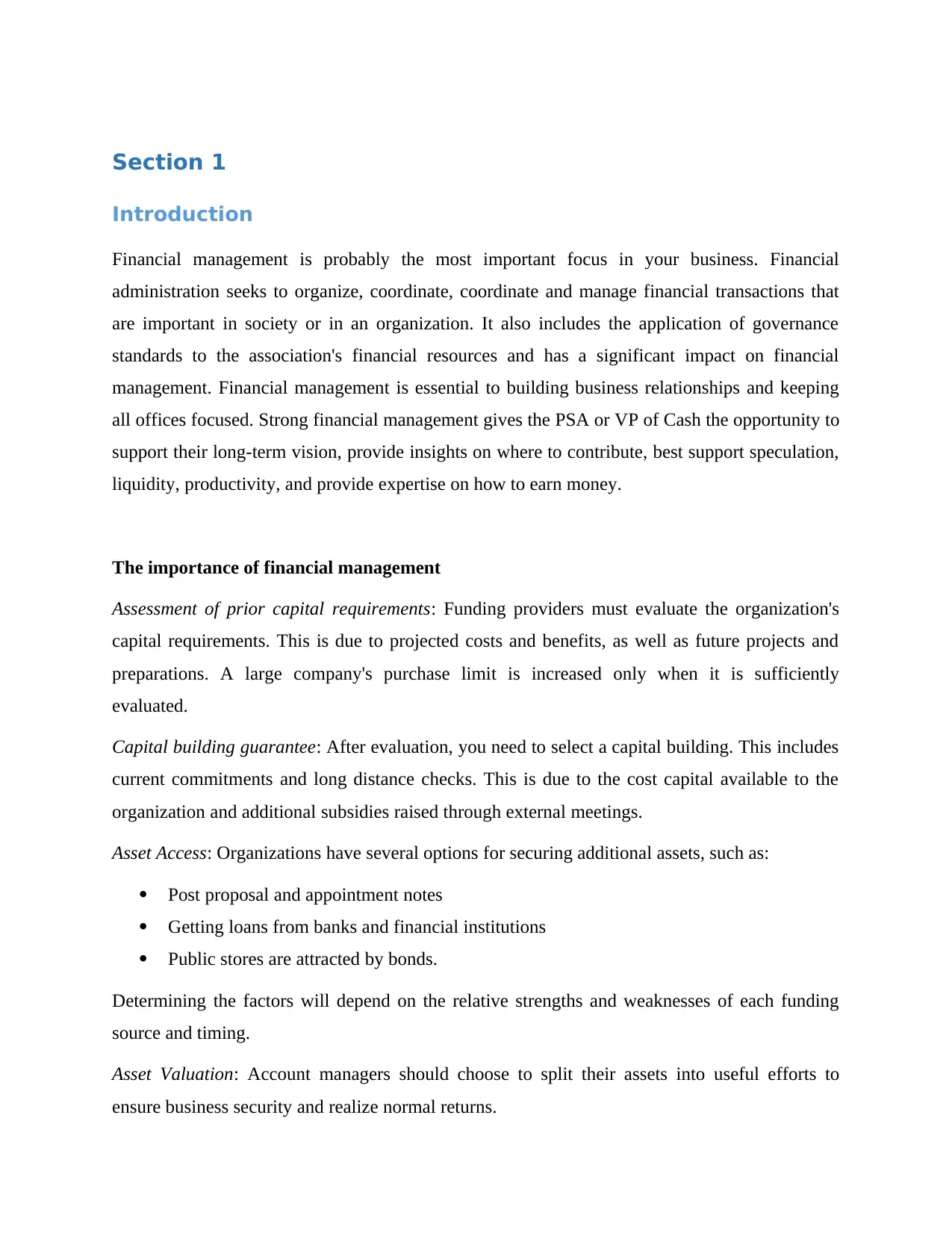
Section 1
Introduction
Financial management is probably the most important focus in your business. Financial
administration seeks to organize, coordinate, coordinate and manage financial transactions that
are important in society or in an organization. It also includes the application of governance
standards to the association's financial resources and has a significant impact on financial
management. Financial management is essential to building business relationships and keeping
all offices focused. Strong financial management gives the PSA or VP of Cash the opportunity to
support their long-term vision, provide insights on where to contribute, best support speculation,
liquidity, productivity, and provide expertise on how to earn money.
The importance of financial management
Assessment of prior capital requirements: Funding providers must evaluate the organization's
capital requirements. This is due to projected costs and benefits, as well as future projects and
preparations. A large company's purchase limit is increased only when it is sufficiently
evaluated.
Capital building guarantee: After evaluation, you need to select a capital building. This includes
current commitments and long distance checks. This is due to the cost capital available to the
organization and additional subsidies raised through external meetings.
Asset Access: Organizations have several options for securing additional assets, such as:
Post proposal and appointment notes
Getting loans from banks and financial institutions
Public stores are attracted by bonds.
Determining the factors will depend on the relative strengths and weaknesses of each funding
source and timing.
Asset Valuation: Account managers should choose to split their assets into useful efforts to
ensure business security and realize normal returns.
Introduction
Financial management is probably the most important focus in your business. Financial
administration seeks to organize, coordinate, coordinate and manage financial transactions that
are important in society or in an organization. It also includes the application of governance
standards to the association's financial resources and has a significant impact on financial
management. Financial management is essential to building business relationships and keeping
all offices focused. Strong financial management gives the PSA or VP of Cash the opportunity to
support their long-term vision, provide insights on where to contribute, best support speculation,
liquidity, productivity, and provide expertise on how to earn money.
The importance of financial management
Assessment of prior capital requirements: Funding providers must evaluate the organization's
capital requirements. This is due to projected costs and benefits, as well as future projects and
preparations. A large company's purchase limit is increased only when it is sufficiently
evaluated.
Capital building guarantee: After evaluation, you need to select a capital building. This includes
current commitments and long distance checks. This is due to the cost capital available to the
organization and additional subsidies raised through external meetings.
Asset Access: Organizations have several options for securing additional assets, such as:
Post proposal and appointment notes
Getting loans from banks and financial institutions
Public stores are attracted by bonds.
Determining the factors will depend on the relative strengths and weaknesses of each funding
source and timing.
Asset Valuation: Account managers should choose to split their assets into useful efforts to
ensure business security and realize normal returns.
Paraphrase This Document
Need a fresh take? Get an instant paraphrase of this document with our AI Paraphraser
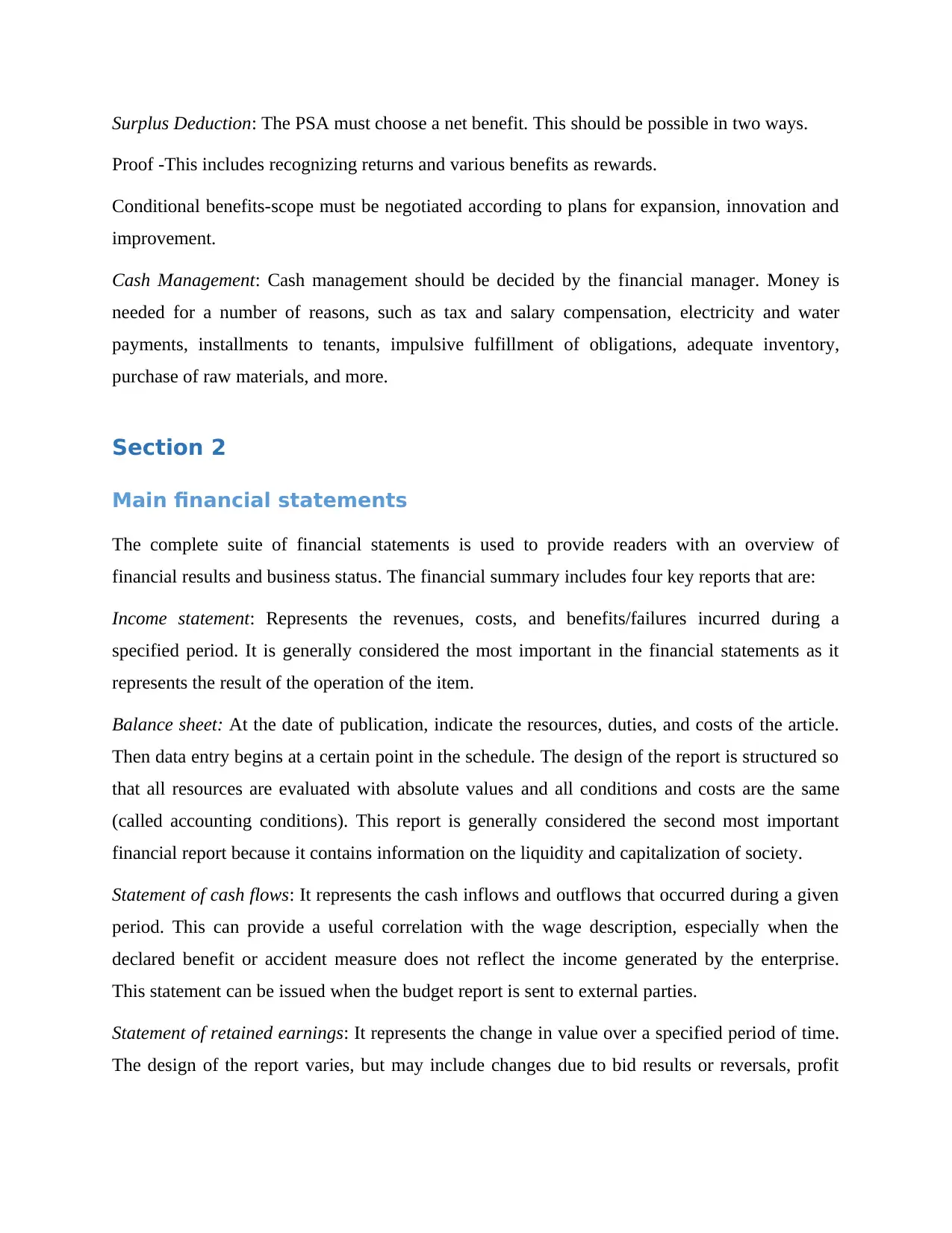
Surplus Deduction: The PSA must choose a net benefit. This should be possible in two ways.
Proof -This includes recognizing returns and various benefits as rewards.
Conditional benefits-scope must be negotiated according to plans for expansion, innovation and
improvement.
Cash Management: Cash management should be decided by the financial manager. Money is
needed for a number of reasons, such as tax and salary compensation, electricity and water
payments, installments to tenants, impulsive fulfillment of obligations, adequate inventory,
purchase of raw materials, and more.
Section 2
Main financial statements
The complete suite of financial statements is used to provide readers with an overview of
financial results and business status. The financial summary includes four key reports that are:
Income statement: Represents the revenues, costs, and benefits/failures incurred during a
specified period. It is generally considered the most important in the financial statements as it
represents the result of the operation of the item.
Balance sheet: At the date of publication, indicate the resources, duties, and costs of the article.
Then data entry begins at a certain point in the schedule. The design of the report is structured so
that all resources are evaluated with absolute values and all conditions and costs are the same
(called accounting conditions). This report is generally considered the second most important
financial report because it contains information on the liquidity and capitalization of society.
Statement of cash flows: It represents the cash inflows and outflows that occurred during a given
period. This can provide a useful correlation with the wage description, especially when the
declared benefit or accident measure does not reflect the income generated by the enterprise.
This statement can be issued when the budget report is sent to external parties.
Statement of retained earnings: It represents the change in value over a specified period of time.
The design of the report varies, but may include changes due to bid results or reversals, profit
Proof -This includes recognizing returns and various benefits as rewards.
Conditional benefits-scope must be negotiated according to plans for expansion, innovation and
improvement.
Cash Management: Cash management should be decided by the financial manager. Money is
needed for a number of reasons, such as tax and salary compensation, electricity and water
payments, installments to tenants, impulsive fulfillment of obligations, adequate inventory,
purchase of raw materials, and more.
Section 2
Main financial statements
The complete suite of financial statements is used to provide readers with an overview of
financial results and business status. The financial summary includes four key reports that are:
Income statement: Represents the revenues, costs, and benefits/failures incurred during a
specified period. It is generally considered the most important in the financial statements as it
represents the result of the operation of the item.
Balance sheet: At the date of publication, indicate the resources, duties, and costs of the article.
Then data entry begins at a certain point in the schedule. The design of the report is structured so
that all resources are evaluated with absolute values and all conditions and costs are the same
(called accounting conditions). This report is generally considered the second most important
financial report because it contains information on the liquidity and capitalization of society.
Statement of cash flows: It represents the cash inflows and outflows that occurred during a given
period. This can provide a useful correlation with the wage description, especially when the
declared benefit or accident measure does not reflect the income generated by the enterprise.
This statement can be issued when the budget report is sent to external parties.
Statement of retained earnings: It represents the change in value over a specified period of time.
The design of the report varies, but may include changes due to bid results or reversals, profit
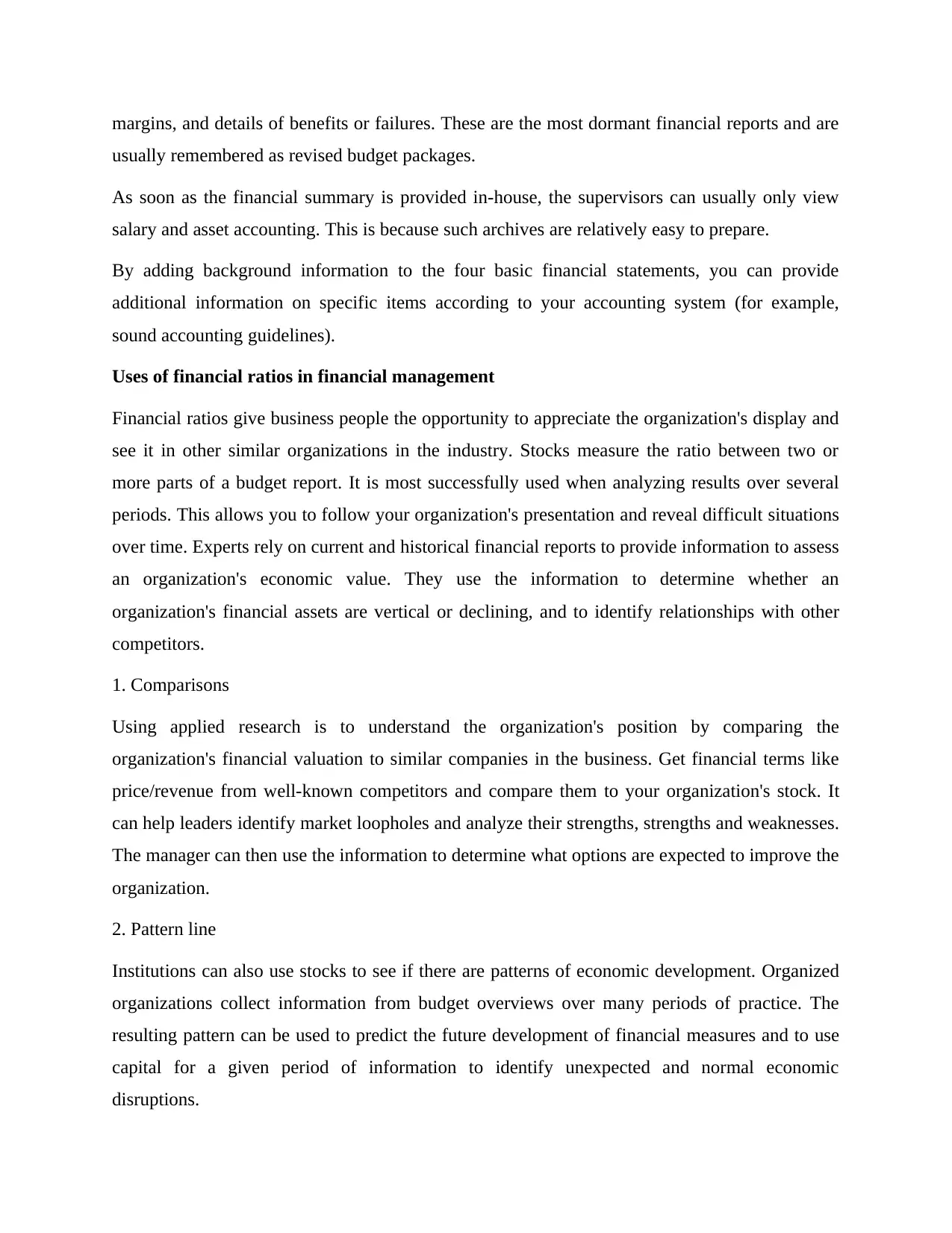
margins, and details of benefits or failures. These are the most dormant financial reports and are
usually remembered as revised budget packages.
As soon as the financial summary is provided in-house, the supervisors can usually only view
salary and asset accounting. This is because such archives are relatively easy to prepare.
By adding background information to the four basic financial statements, you can provide
additional information on specific items according to your accounting system (for example,
sound accounting guidelines).
Uses of financial ratios in financial management
Financial ratios give business people the opportunity to appreciate the organization's display and
see it in other similar organizations in the industry. Stocks measure the ratio between two or
more parts of a budget report. It is most successfully used when analyzing results over several
periods. This allows you to follow your organization's presentation and reveal difficult situations
over time. Experts rely on current and historical financial reports to provide information to assess
an organization's economic value. They use the information to determine whether an
organization's financial assets are vertical or declining, and to identify relationships with other
competitors.
1. Comparisons
Using applied research is to understand the organization's position by comparing the
organization's financial valuation to similar companies in the business. Get financial terms like
price/revenue from well-known competitors and compare them to your organization's stock. It
can help leaders identify market loopholes and analyze their strengths, strengths and weaknesses.
The manager can then use the information to determine what options are expected to improve the
organization.
2. Pattern line
Institutions can also use stocks to see if there are patterns of economic development. Organized
organizations collect information from budget overviews over many periods of practice. The
resulting pattern can be used to predict the future development of financial measures and to use
capital for a given period of information to identify unexpected and normal economic
disruptions.
usually remembered as revised budget packages.
As soon as the financial summary is provided in-house, the supervisors can usually only view
salary and asset accounting. This is because such archives are relatively easy to prepare.
By adding background information to the four basic financial statements, you can provide
additional information on specific items according to your accounting system (for example,
sound accounting guidelines).
Uses of financial ratios in financial management
Financial ratios give business people the opportunity to appreciate the organization's display and
see it in other similar organizations in the industry. Stocks measure the ratio between two or
more parts of a budget report. It is most successfully used when analyzing results over several
periods. This allows you to follow your organization's presentation and reveal difficult situations
over time. Experts rely on current and historical financial reports to provide information to assess
an organization's economic value. They use the information to determine whether an
organization's financial assets are vertical or declining, and to identify relationships with other
competitors.
1. Comparisons
Using applied research is to understand the organization's position by comparing the
organization's financial valuation to similar companies in the business. Get financial terms like
price/revenue from well-known competitors and compare them to your organization's stock. It
can help leaders identify market loopholes and analyze their strengths, strengths and weaknesses.
The manager can then use the information to determine what options are expected to improve the
organization.
2. Pattern line
Institutions can also use stocks to see if there are patterns of economic development. Organized
organizations collect information from budget overviews over many periods of practice. The
resulting pattern can be used to predict the future development of financial measures and to use
capital for a given period of information to identify unexpected and normal economic
disruptions.
⊘ This is a preview!⊘
Do you want full access?
Subscribe today to unlock all pages.

Trusted by 1+ million students worldwide
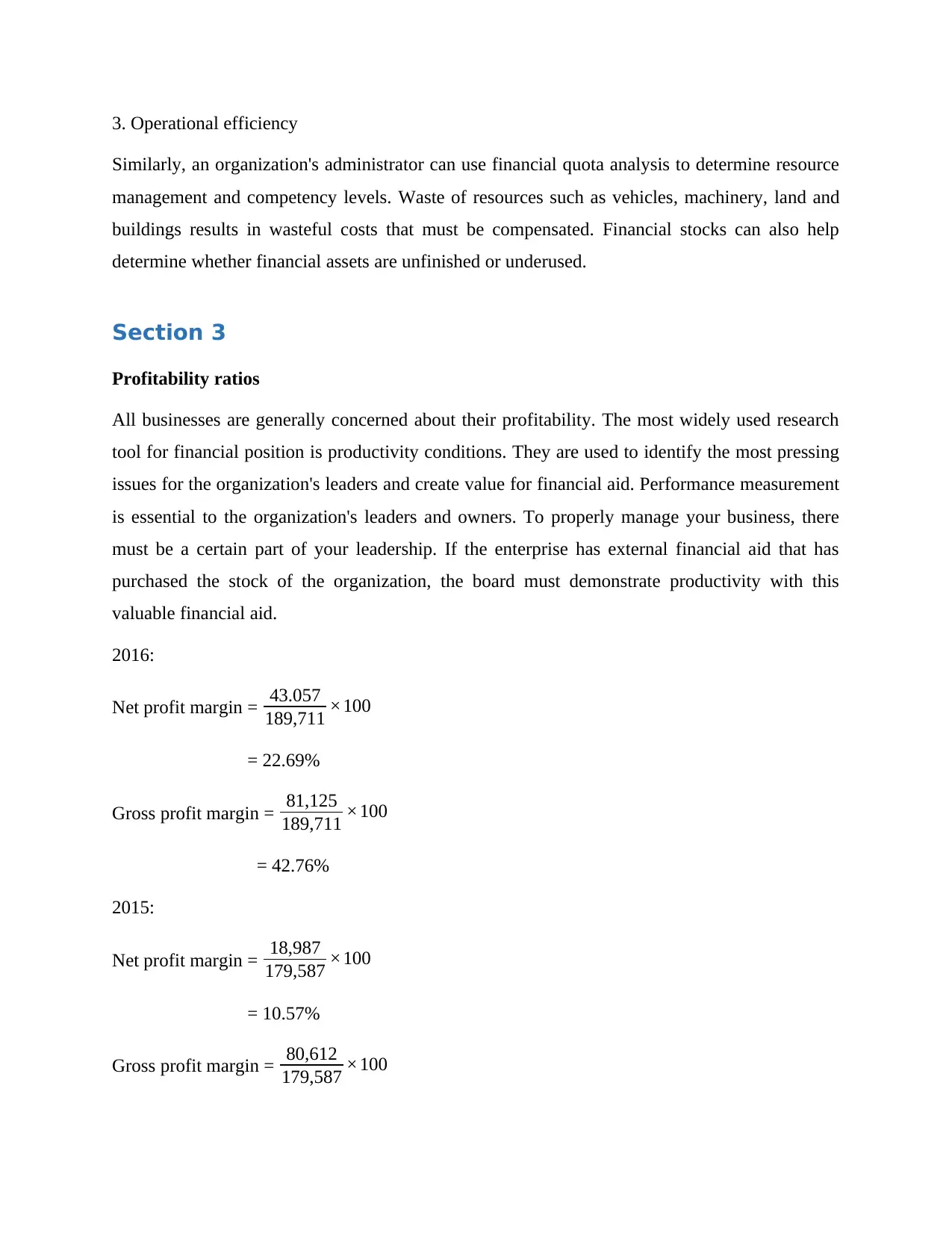
3. Operational efficiency
Similarly, an organization's administrator can use financial quota analysis to determine resource
management and competency levels. Waste of resources such as vehicles, machinery, land and
buildings results in wasteful costs that must be compensated. Financial stocks can also help
determine whether financial assets are unfinished or underused.
Section 3
Profitability ratios
All businesses are generally concerned about their profitability. The most widely used research
tool for financial position is productivity conditions. They are used to identify the most pressing
issues for the organization's leaders and create value for financial aid. Performance measurement
is essential to the organization's leaders and owners. To properly manage your business, there
must be a certain part of your leadership. If the enterprise has external financial aid that has
purchased the stock of the organization, the board must demonstrate productivity with this
valuable financial aid.
2016:
Net profit margin = 43.057
189,711 ×100
= 22.69%
Gross profit margin = 81,125
189,711 ×100
= 42.76%
2015:
Net profit margin = 18,987
179,587 ×100
= 10.57%
Gross profit margin = 80,612
179,587 ×100
Similarly, an organization's administrator can use financial quota analysis to determine resource
management and competency levels. Waste of resources such as vehicles, machinery, land and
buildings results in wasteful costs that must be compensated. Financial stocks can also help
determine whether financial assets are unfinished or underused.
Section 3
Profitability ratios
All businesses are generally concerned about their profitability. The most widely used research
tool for financial position is productivity conditions. They are used to identify the most pressing
issues for the organization's leaders and create value for financial aid. Performance measurement
is essential to the organization's leaders and owners. To properly manage your business, there
must be a certain part of your leadership. If the enterprise has external financial aid that has
purchased the stock of the organization, the board must demonstrate productivity with this
valuable financial aid.
2016:
Net profit margin = 43.057
189,711 ×100
= 22.69%
Gross profit margin = 81,125
189,711 ×100
= 42.76%
2015:
Net profit margin = 18,987
179,587 ×100
= 10.57%
Gross profit margin = 80,612
179,587 ×100
Paraphrase This Document
Need a fresh take? Get an instant paraphrase of this document with our AI Paraphraser
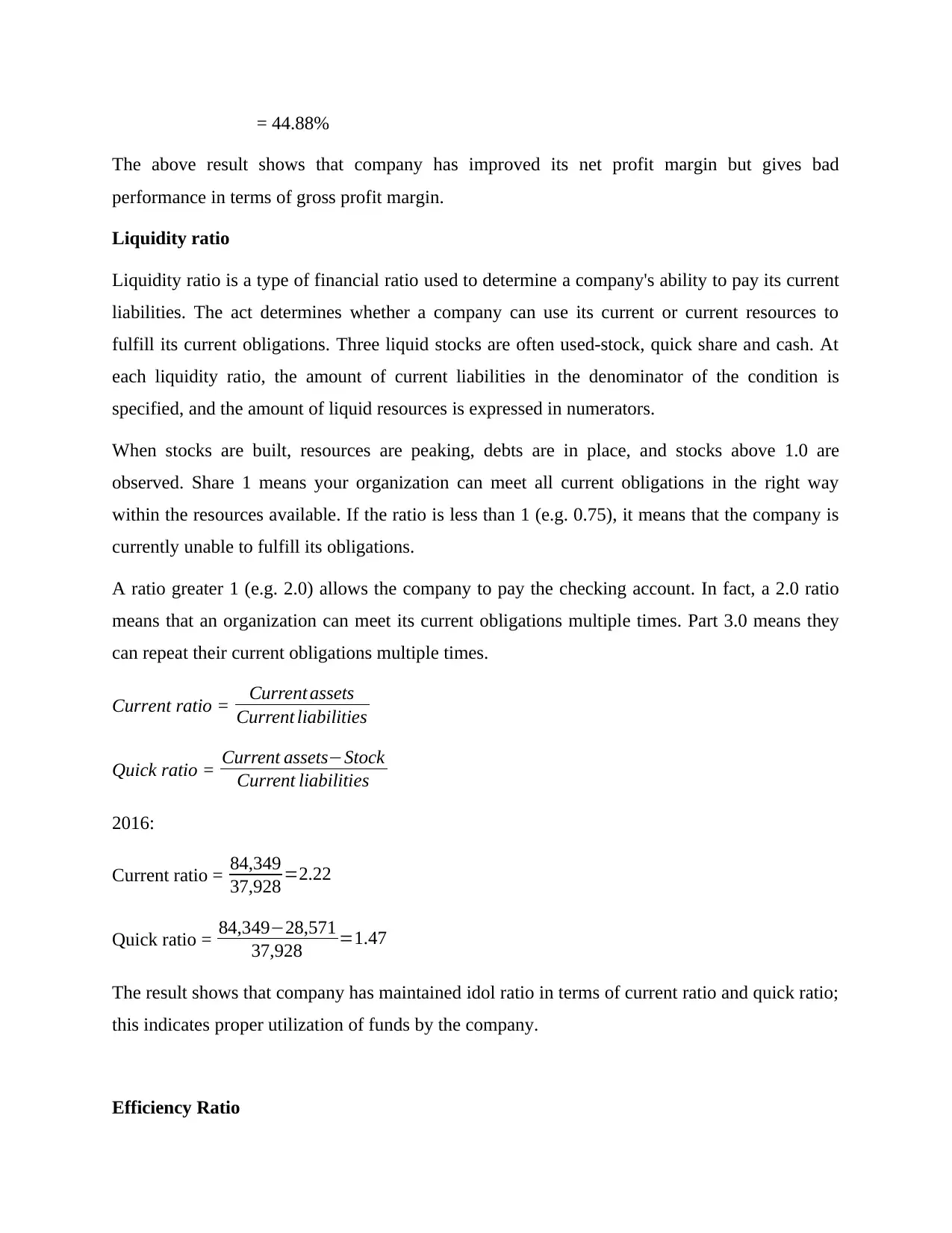
= 44.88%
The above result shows that company has improved its net profit margin but gives bad
performance in terms of gross profit margin.
Liquidity ratio
Liquidity ratio is a type of financial ratio used to determine a company's ability to pay its current
liabilities. The act determines whether a company can use its current or current resources to
fulfill its current obligations. Three liquid stocks are often used-stock, quick share and cash. At
each liquidity ratio, the amount of current liabilities in the denominator of the condition is
specified, and the amount of liquid resources is expressed in numerators.
When stocks are built, resources are peaking, debts are in place, and stocks above 1.0 are
observed. Share 1 means your organization can meet all current obligations in the right way
within the resources available. If the ratio is less than 1 (e.g. 0.75), it means that the company is
currently unable to fulfill its obligations.
A ratio greater 1 (e.g. 2.0) allows the company to pay the checking account. In fact, a 2.0 ratio
means that an organization can meet its current obligations multiple times. Part 3.0 means they
can repeat their current obligations multiple times.
Current ratio = Current assets
Current liabilities
Quick ratio = Current assets−Stock
Current liabilities
2016:
Current ratio = 84,349
37,928 =2.22
Quick ratio = 84,349−28,571
37,928 =1.47
The result shows that company has maintained idol ratio in terms of current ratio and quick ratio;
this indicates proper utilization of funds by the company.
Efficiency Ratio
The above result shows that company has improved its net profit margin but gives bad
performance in terms of gross profit margin.
Liquidity ratio
Liquidity ratio is a type of financial ratio used to determine a company's ability to pay its current
liabilities. The act determines whether a company can use its current or current resources to
fulfill its current obligations. Three liquid stocks are often used-stock, quick share and cash. At
each liquidity ratio, the amount of current liabilities in the denominator of the condition is
specified, and the amount of liquid resources is expressed in numerators.
When stocks are built, resources are peaking, debts are in place, and stocks above 1.0 are
observed. Share 1 means your organization can meet all current obligations in the right way
within the resources available. If the ratio is less than 1 (e.g. 0.75), it means that the company is
currently unable to fulfill its obligations.
A ratio greater 1 (e.g. 2.0) allows the company to pay the checking account. In fact, a 2.0 ratio
means that an organization can meet its current obligations multiple times. Part 3.0 means they
can repeat their current obligations multiple times.
Current ratio = Current assets
Current liabilities
Quick ratio = Current assets−Stock
Current liabilities
2016:
Current ratio = 84,349
37,928 =2.22
Quick ratio = 84,349−28,571
37,928 =1.47
The result shows that company has maintained idol ratio in terms of current ratio and quick ratio;
this indicates proper utilization of funds by the company.
Efficiency Ratio
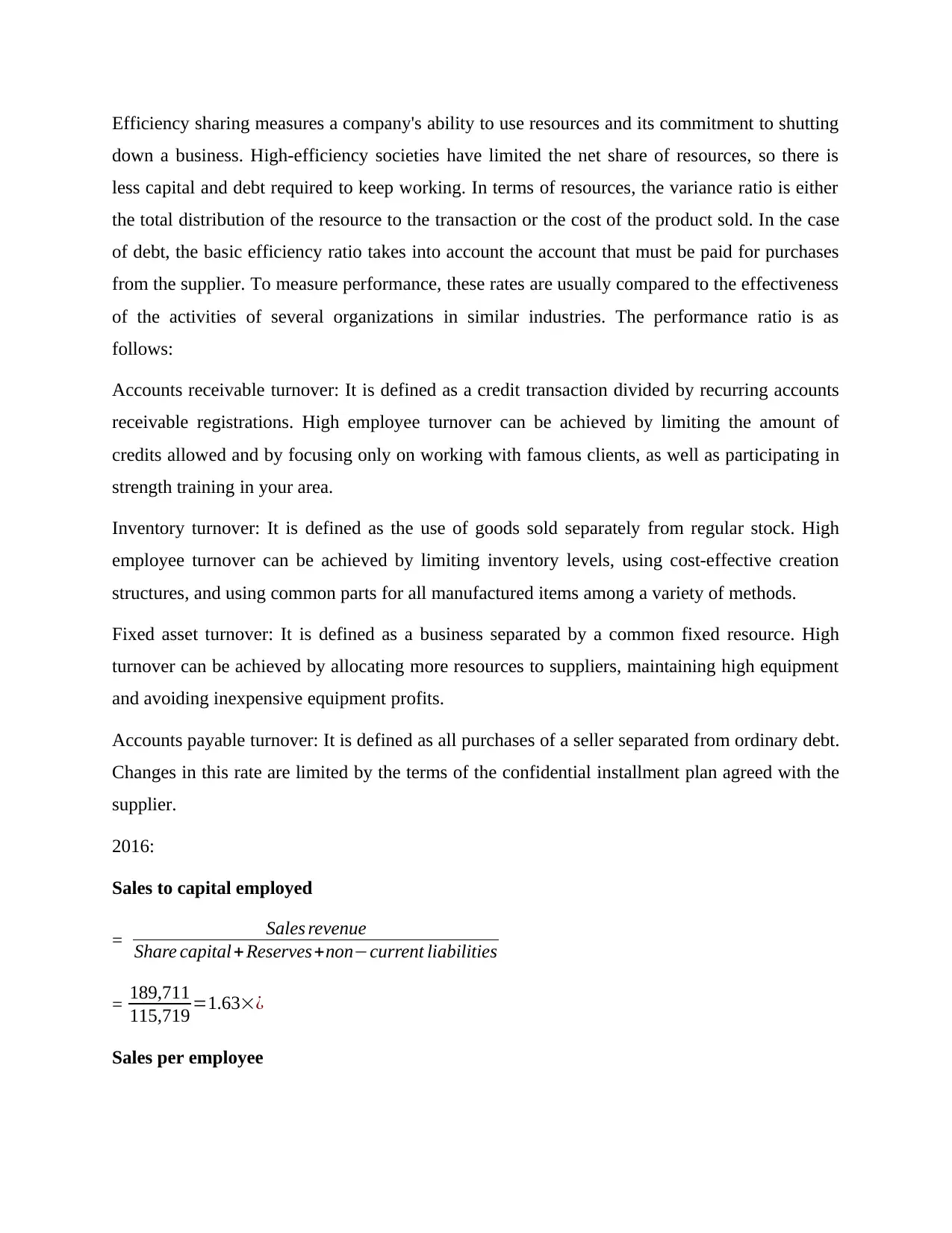
Efficiency sharing measures a company's ability to use resources and its commitment to shutting
down a business. High-efficiency societies have limited the net share of resources, so there is
less capital and debt required to keep working. In terms of resources, the variance ratio is either
the total distribution of the resource to the transaction or the cost of the product sold. In the case
of debt, the basic efficiency ratio takes into account the account that must be paid for purchases
from the supplier. To measure performance, these rates are usually compared to the effectiveness
of the activities of several organizations in similar industries. The performance ratio is as
follows:
Accounts receivable turnover: It is defined as a credit transaction divided by recurring accounts
receivable registrations. High employee turnover can be achieved by limiting the amount of
credits allowed and by focusing only on working with famous clients, as well as participating in
strength training in your area.
Inventory turnover: It is defined as the use of goods sold separately from regular stock. High
employee turnover can be achieved by limiting inventory levels, using cost-effective creation
structures, and using common parts for all manufactured items among a variety of methods.
Fixed asset turnover: It is defined as a business separated by a common fixed resource. High
turnover can be achieved by allocating more resources to suppliers, maintaining high equipment
and avoiding inexpensive equipment profits.
Accounts payable turnover: It is defined as all purchases of a seller separated from ordinary debt.
Changes in this rate are limited by the terms of the confidential installment plan agreed with the
supplier.
2016:
Sales to capital employed
= Sales revenue
Share capital +Reserves+non−current liabilities
= 189,711
115,719 =1.63׿
Sales per employee
down a business. High-efficiency societies have limited the net share of resources, so there is
less capital and debt required to keep working. In terms of resources, the variance ratio is either
the total distribution of the resource to the transaction or the cost of the product sold. In the case
of debt, the basic efficiency ratio takes into account the account that must be paid for purchases
from the supplier. To measure performance, these rates are usually compared to the effectiveness
of the activities of several organizations in similar industries. The performance ratio is as
follows:
Accounts receivable turnover: It is defined as a credit transaction divided by recurring accounts
receivable registrations. High employee turnover can be achieved by limiting the amount of
credits allowed and by focusing only on working with famous clients, as well as participating in
strength training in your area.
Inventory turnover: It is defined as the use of goods sold separately from regular stock. High
employee turnover can be achieved by limiting inventory levels, using cost-effective creation
structures, and using common parts for all manufactured items among a variety of methods.
Fixed asset turnover: It is defined as a business separated by a common fixed resource. High
turnover can be achieved by allocating more resources to suppliers, maintaining high equipment
and avoiding inexpensive equipment profits.
Accounts payable turnover: It is defined as all purchases of a seller separated from ordinary debt.
Changes in this rate are limited by the terms of the confidential installment plan agreed with the
supplier.
2016:
Sales to capital employed
= Sales revenue
Share capital +Reserves+non−current liabilities
= 189,711
115,719 =1.63׿
Sales per employee
⊘ This is a preview!⊘
Do you want full access?
Subscribe today to unlock all pages.

Trusted by 1+ million students worldwide
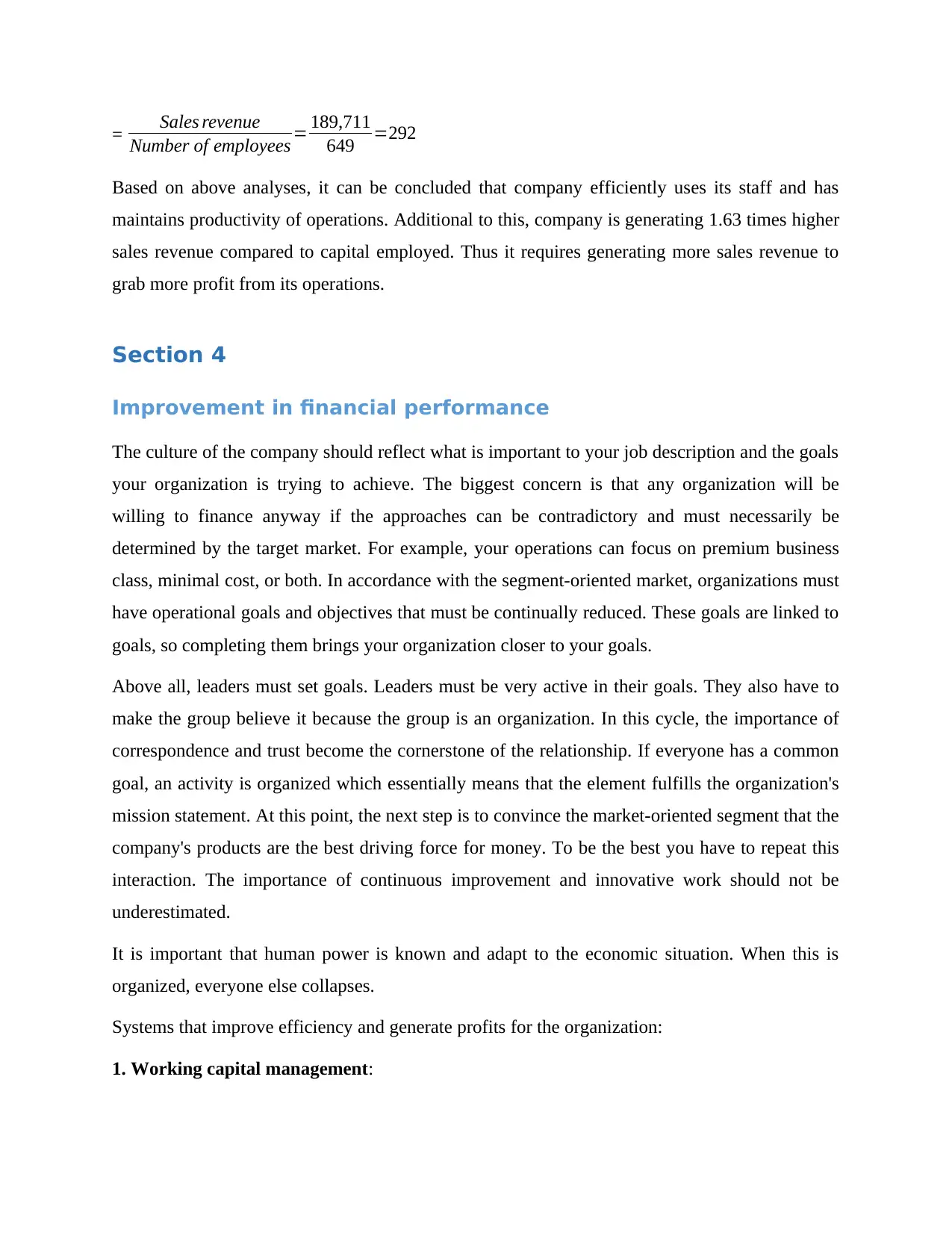
= Sales revenue
Number of employees = 189,711
649 =292
Based on above analyses, it can be concluded that company efficiently uses its staff and has
maintains productivity of operations. Additional to this, company is generating 1.63 times higher
sales revenue compared to capital employed. Thus it requires generating more sales revenue to
grab more profit from its operations.
Section 4
Improvement in financial performance
The culture of the company should reflect what is important to your job description and the goals
your organization is trying to achieve. The biggest concern is that any organization will be
willing to finance anyway if the approaches can be contradictory and must necessarily be
determined by the target market. For example, your operations can focus on premium business
class, minimal cost, or both. In accordance with the segment-oriented market, organizations must
have operational goals and objectives that must be continually reduced. These goals are linked to
goals, so completing them brings your organization closer to your goals.
Above all, leaders must set goals. Leaders must be very active in their goals. They also have to
make the group believe it because the group is an organization. In this cycle, the importance of
correspondence and trust become the cornerstone of the relationship. If everyone has a common
goal, an activity is organized which essentially means that the element fulfills the organization's
mission statement. At this point, the next step is to convince the market-oriented segment that the
company's products are the best driving force for money. To be the best you have to repeat this
interaction. The importance of continuous improvement and innovative work should not be
underestimated.
It is important that human power is known and adapt to the economic situation. When this is
organized, everyone else collapses.
Systems that improve efficiency and generate profits for the organization:
1. Working capital management:
Number of employees = 189,711
649 =292
Based on above analyses, it can be concluded that company efficiently uses its staff and has
maintains productivity of operations. Additional to this, company is generating 1.63 times higher
sales revenue compared to capital employed. Thus it requires generating more sales revenue to
grab more profit from its operations.
Section 4
Improvement in financial performance
The culture of the company should reflect what is important to your job description and the goals
your organization is trying to achieve. The biggest concern is that any organization will be
willing to finance anyway if the approaches can be contradictory and must necessarily be
determined by the target market. For example, your operations can focus on premium business
class, minimal cost, or both. In accordance with the segment-oriented market, organizations must
have operational goals and objectives that must be continually reduced. These goals are linked to
goals, so completing them brings your organization closer to your goals.
Above all, leaders must set goals. Leaders must be very active in their goals. They also have to
make the group believe it because the group is an organization. In this cycle, the importance of
correspondence and trust become the cornerstone of the relationship. If everyone has a common
goal, an activity is organized which essentially means that the element fulfills the organization's
mission statement. At this point, the next step is to convince the market-oriented segment that the
company's products are the best driving force for money. To be the best you have to repeat this
interaction. The importance of continuous improvement and innovative work should not be
underestimated.
It is important that human power is known and adapt to the economic situation. When this is
organized, everyone else collapses.
Systems that improve efficiency and generate profits for the organization:
1. Working capital management:
Paraphrase This Document
Need a fresh take? Get an instant paraphrase of this document with our AI Paraphraser
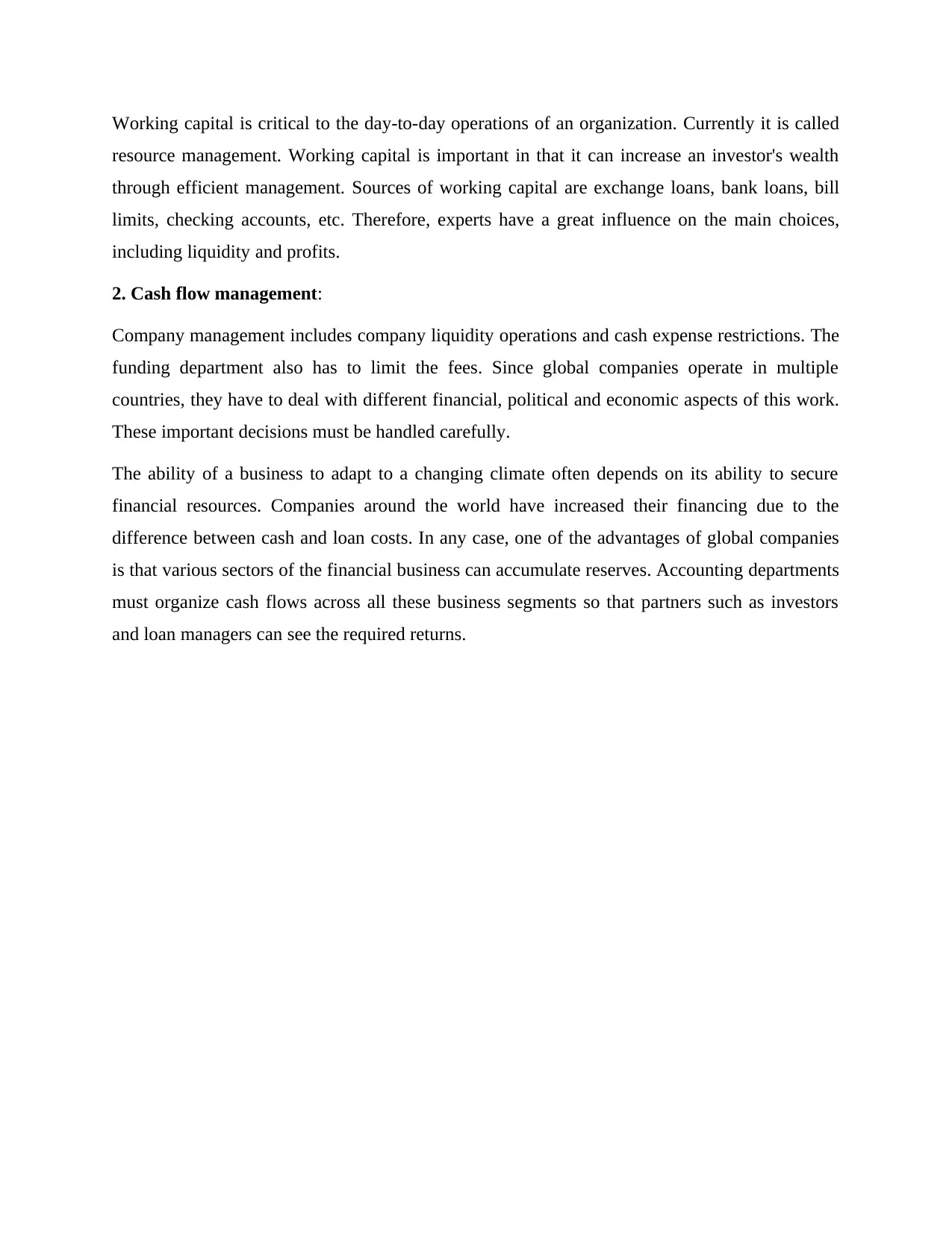
Working capital is critical to the day-to-day operations of an organization. Currently it is called
resource management. Working capital is important in that it can increase an investor's wealth
through efficient management. Sources of working capital are exchange loans, bank loans, bill
limits, checking accounts, etc. Therefore, experts have a great influence on the main choices,
including liquidity and profits.
2. Cash flow management:
Company management includes company liquidity operations and cash expense restrictions. The
funding department also has to limit the fees. Since global companies operate in multiple
countries, they have to deal with different financial, political and economic aspects of this work.
These important decisions must be handled carefully.
The ability of a business to adapt to a changing climate often depends on its ability to secure
financial resources. Companies around the world have increased their financing due to the
difference between cash and loan costs. In any case, one of the advantages of global companies
is that various sectors of the financial business can accumulate reserves. Accounting departments
must organize cash flows across all these business segments so that partners such as investors
and loan managers can see the required returns.
resource management. Working capital is important in that it can increase an investor's wealth
through efficient management. Sources of working capital are exchange loans, bank loans, bill
limits, checking accounts, etc. Therefore, experts have a great influence on the main choices,
including liquidity and profits.
2. Cash flow management:
Company management includes company liquidity operations and cash expense restrictions. The
funding department also has to limit the fees. Since global companies operate in multiple
countries, they have to deal with different financial, political and economic aspects of this work.
These important decisions must be handled carefully.
The ability of a business to adapt to a changing climate often depends on its ability to secure
financial resources. Companies around the world have increased their financing due to the
difference between cash and loan costs. In any case, one of the advantages of global companies
is that various sectors of the financial business can accumulate reserves. Accounting departments
must organize cash flows across all these business segments so that partners such as investors
and loan managers can see the required returns.
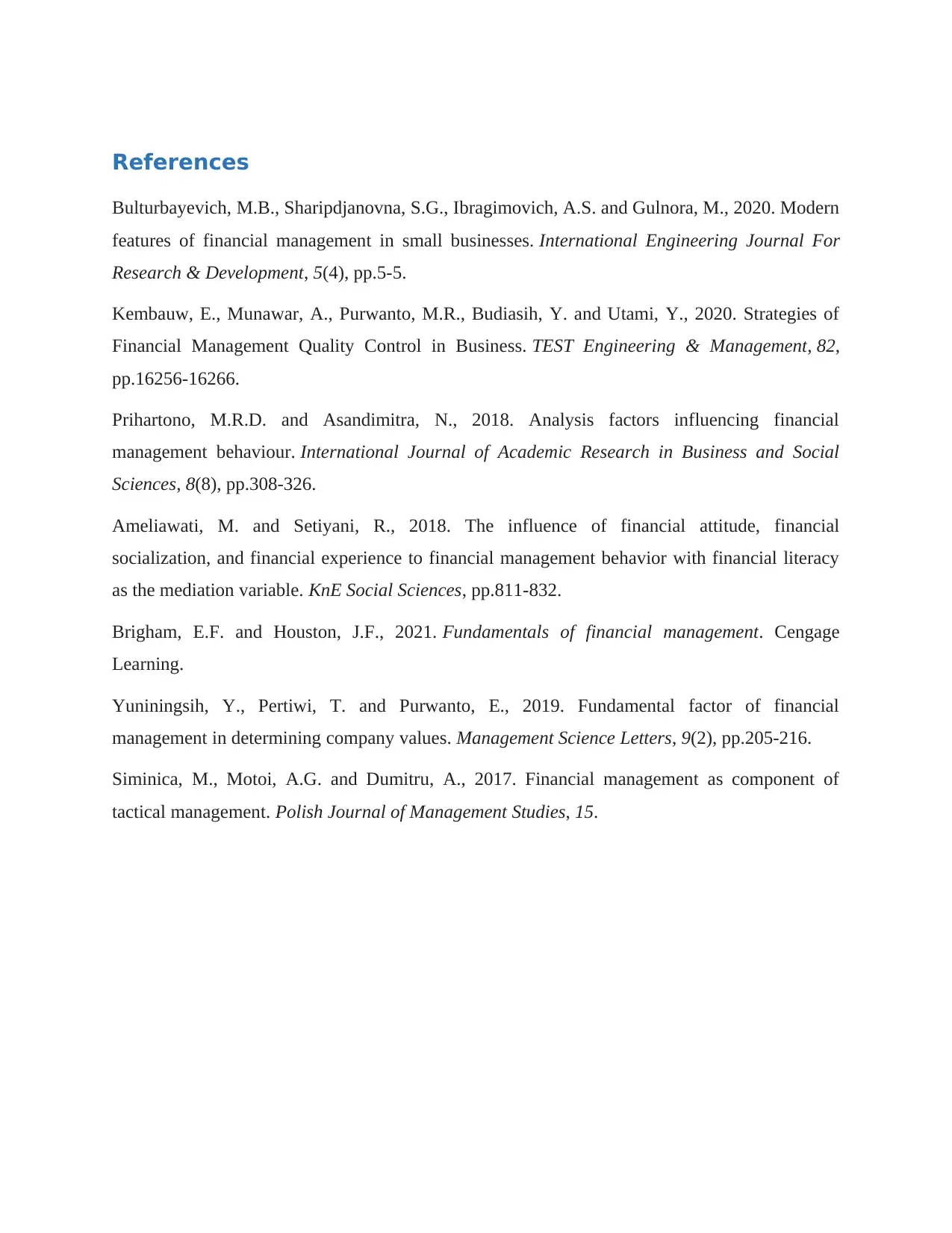
References
Bulturbayevich, M.B., Sharipdjanovna, S.G., Ibragimovich, A.S. and Gulnora, M., 2020. Modern
features of financial management in small businesses. International Engineering Journal For
Research & Development, 5(4), pp.5-5.
Kembauw, E., Munawar, A., Purwanto, M.R., Budiasih, Y. and Utami, Y., 2020. Strategies of
Financial Management Quality Control in Business. TEST Engineering & Management, 82,
pp.16256-16266.
Prihartono, M.R.D. and Asandimitra, N., 2018. Analysis factors influencing financial
management behaviour. International Journal of Academic Research in Business and Social
Sciences, 8(8), pp.308-326.
Ameliawati, M. and Setiyani, R., 2018. The influence of financial attitude, financial
socialization, and financial experience to financial management behavior with financial literacy
as the mediation variable. KnE Social Sciences, pp.811-832.
Brigham, E.F. and Houston, J.F., 2021. Fundamentals of financial management. Cengage
Learning.
Yuniningsih, Y., Pertiwi, T. and Purwanto, E., 2019. Fundamental factor of financial
management in determining company values. Management Science Letters, 9(2), pp.205-216.
Siminica, M., Motoi, A.G. and Dumitru, A., 2017. Financial management as component of
tactical management. Polish Journal of Management Studies, 15.
Bulturbayevich, M.B., Sharipdjanovna, S.G., Ibragimovich, A.S. and Gulnora, M., 2020. Modern
features of financial management in small businesses. International Engineering Journal For
Research & Development, 5(4), pp.5-5.
Kembauw, E., Munawar, A., Purwanto, M.R., Budiasih, Y. and Utami, Y., 2020. Strategies of
Financial Management Quality Control in Business. TEST Engineering & Management, 82,
pp.16256-16266.
Prihartono, M.R.D. and Asandimitra, N., 2018. Analysis factors influencing financial
management behaviour. International Journal of Academic Research in Business and Social
Sciences, 8(8), pp.308-326.
Ameliawati, M. and Setiyani, R., 2018. The influence of financial attitude, financial
socialization, and financial experience to financial management behavior with financial literacy
as the mediation variable. KnE Social Sciences, pp.811-832.
Brigham, E.F. and Houston, J.F., 2021. Fundamentals of financial management. Cengage
Learning.
Yuniningsih, Y., Pertiwi, T. and Purwanto, E., 2019. Fundamental factor of financial
management in determining company values. Management Science Letters, 9(2), pp.205-216.
Siminica, M., Motoi, A.G. and Dumitru, A., 2017. Financial management as component of
tactical management. Polish Journal of Management Studies, 15.
⊘ This is a preview!⊘
Do you want full access?
Subscribe today to unlock all pages.

Trusted by 1+ million students worldwide
1 out of 15
Related Documents
Your All-in-One AI-Powered Toolkit for Academic Success.
+13062052269
info@desklib.com
Available 24*7 on WhatsApp / Email
![[object Object]](/_next/static/media/star-bottom.7253800d.svg)
Unlock your academic potential
Copyright © 2020–2025 A2Z Services. All Rights Reserved. Developed and managed by ZUCOL.




